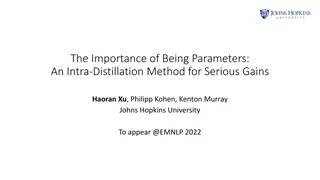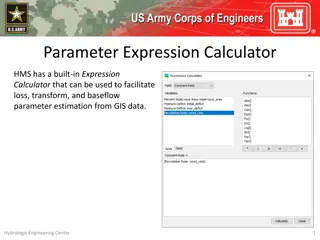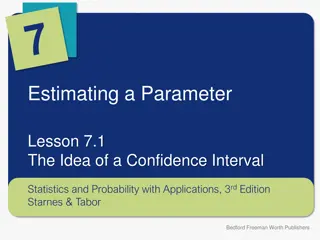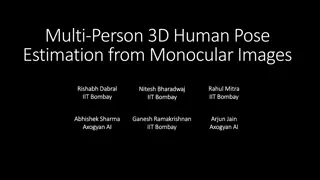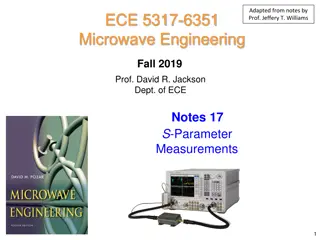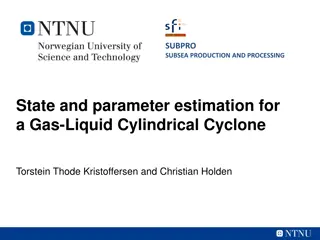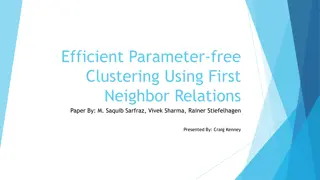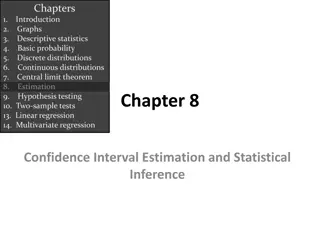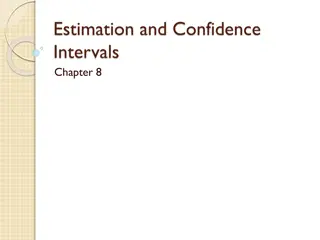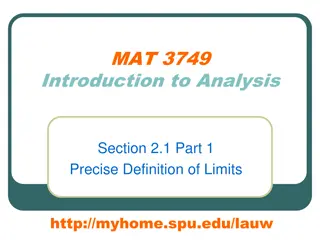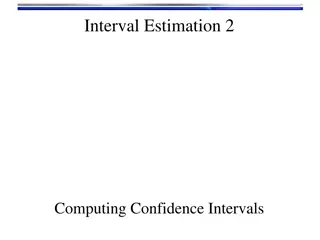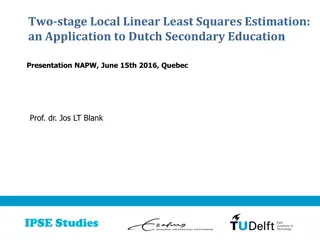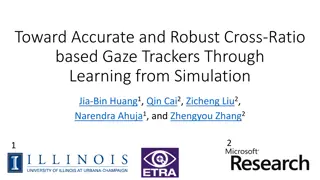Understanding Confidence Limits in Parameter Estimation
Confidence limits are commonly used to summarize the probability distribution of errors in parameter estimation. Experimenters choose both the confidence level and shape of the confidence region, with customary percentages like 68.3%, 95.4%, and 99%. Ellipses or ellipsoids are often used in higher dimensions. Chi-square minimization leads to natural choices for confidence intervals. It's crucial to inspire confidence in the measured values by selecting appropriate confidence regions that contain specified probabilities.
- Confidence limits
- Parameter estimation
- Probability distribution
- Chi-square minimization
- Confidence intervals
Uploaded on Oct 11, 2024 | 0 Views
Download Presentation

Please find below an Image/Link to download the presentation.
The content on the website is provided AS IS for your information and personal use only. It may not be sold, licensed, or shared on other websites without obtaining consent from the author. Download presentation by click this link. If you encounter any issues during the download, it is possible that the publisher has removed the file from their server.
E N D
Presentation Transcript
Confidence Limits Rather than present all details of the probability distribution of errors in parameter estimation, it is common practice to summarize the distribution in the form of confidence limits. The full probability distribution is a function defined on the M- dimensional space of parameters a. A confidence region (or confidence interval) is just a region of that M-dimensional space (hopefully a small region) that contains a certain (hopefully large) percentage of the total probability distribution. You point to a confidence region and say, e.g., there is a 99% chance that the true parameter values fall within this region around the measured value. It is worth emphasizing that you, the experimenter, get to pick both the confidence level (99% in the above example) and the shape of the confidence region. The only requirement is that your region does include the stated percentage of probability. Certain percentages are, however, customary in scientific usage: 68.3% (the lowest confidence worthy of quoting), 90%, 95.4%, 99%, and 99.73%. Higher confidence levels are conventionally ninety-nine point nine nine. As for shape, obviously you want a region that is compact and reasonably centered on your measurement a(0), since the whole purpose of a confidence limit is to inspire confidence in that measured value. In one dimension, the convention is to use a line segment centered on the measured value; in higher dimensions, ellipses or ellipsoids are most frequently used.
You might suspect, correctly, that the numbers 68.3%, 95.4%, and 99.73%, and the use of ellipsoids, have some connection with a normal distribution. That is true historically, but not always relevant nowadays. In general, the probability distribution of the parameters will not be normal, and the above numbers, used as levels of confidence, are purely matters of convention. Figure 15.6.3 sketches a possible probability distribution for the case M = 2. Shown are three different confidence regions that might usefully be given, all at the same confidence level. The two vertical lines enclose a band (horizontal interval) that represents the 68% confidence interval for the variable a0without regard to the value of a1. Similarly the horizontal lines enclose a 68% confidence interval for a1. The ellipse shows a 68% confidence interval for a0and a1jointly. Notice that to enclose the same probability as the two bands, the ellipse must necessarily extend outside of both of them.
Constant Chi-Square Boundaries as Confidence Limits When the method used to estimate the parameters a(0)is chi- square minimization, then there is a natural choice for the shape of confidence intervals, whose use is almost universal. For the observed data set D(0), the value of 2is a minimum at a(0). Call this minimum value 2min. If the vector a of parameter values is perturbed away from a(0), then 2increases. The region within which 2increases by no more than a set amount 2defines some M-dimensional confidence region around a(0). If 2is set to be a large number, this will be a big region; if it is small, it will be small. Somewhere in between there will be choices of 2that cause the region to contain, variously, 68%, 90%, etc., of probability distribution for a s, as defined above. These regions are taken as the confidence regions for the parameters a(0).
Very frequently one is interested not in the full M-dimensional confidence region, but in individual confidence regions for some smaller number of parameters. For example, one might be interested in the confidence interval of each parameter taken separately (the bands in Figure 15.6.3), in which case v = 1. In that case, the natural confidence regions in the v-dimensional subspace of the M-dimensional parameter space are the projections of the M-dimensional regions defined by fixed 2 into the v-dimensional spaces of interest. In Figure 15.6.4, for the case M = 2, we show regions corresponding to several values of 2. The one-dimensional confidence interval in a1corresponding to the region bounded by 2= 1 lies between the lines A and A . Note that it is the projection of the higher- dimensional region on the lower dimension space that is used, not the intersection. The intersection would be the band between Z and Z . It is never used. It is shown in the figure only for the purpose of making this cautionary point, that it should not be confused with the projection.
Probability Distribution of Parameters in the Normal Case Up to now we have made no connection at all with the error estimates that come out of the 2fitting procedure, most notably the covariance matrix Cij. The reason is this: 2minimization is a useful means for estimating parameters even if the measurement errors are not normally distributed. While normally distributed errors are required if the 2 parameter estimate is to be a maximum likelihood estimator, one is often willing to give up that property in return for the relative convenience of the 2procedure. Only in extreme cases, i.e., measurement error distributions with very large tails, is 2 minimization abandoned in favor of more robust techniques. However, the formal covariance matrix that comes out of a 2 minimization has a clear quantitative interpretation only if (or to the extent that) the measurement errors actually are normally distributed.
In the case of nonnormal errors, you are allowed to fit for parameters by minimizing 2 to use a contour of constant 2as the boundary of your confidence region to use Monte Carlo simulation or detailed analytic calculation in determining which contour 2is the correct one for your desired confidence level to give the covariance matrix Cijas the formal covariance matrix of the fit. You are not allowed to use formulas that we now give for the case of normal errors, which establish quantitative relationships among 2, Cij, and the confidence level.
Here are the key theorems that hold when (i) the measurement errors are normally distributed, and either (ii) the model is linear in its parameters or (iii) the sample size is large enough that the uncertainties in the fitted parameters a do not extend outside a region in which the model could be replaced by a suitable linearized model. Theorem A. 2minis distributed as a chi-square distribution with N - M degrees of freedom, where N is the number of data points and M is the number of fitted parameters. This is the basic theorem that lets you evaluate the goodness-of-fit of the model. We list it first to remind that unless the goodness-of-fit is credible, the whole estimation of parameters is suspect. Theorem B. If aS(j)is drawn from the universe of simulated data sets with actual parameters a(0), then the probability distribution of a = aS(j) a(0) is the multivariate normal distribution where is the curvature matrix.
Theorem C. If aS(j)is drawn from the universe of simulated data sets with actual parameters a(0), then the quantity 2= 2(a(j ) 2(a(0)) is distributed as a chi-square distribution with M degrees of freedom. Here the 2 s are all evaluated using the fixed (actual) data set D(0). This theorem makes the connection between particular values of 2 and the fraction of the probability distribution that they enclose as an M- dimensional region, i.e., the confidence level of the M-dimensional confidence region. Theorem D. Suppose that aS(j)is drawn from the universe of simulated data sets (as above); that its first components a0, , av-1are held fixed; and that its remaining M - v components are varied so as to minimize 2. Call this minimum value 2v . Then 2v= 2v - 2minis distributed as a chi- square distribution with v degrees of freedom. If you consult Figure 15.6.4, you will see that this theorem connects the projected 2region with a confidence level. In the figure, a point that is held fixed in a1and allowed to vary in a0minimizing 2will seek out the ellipse whose top or bottom edge is tangent to the line of constant a1, and is therefore the line that projects it onto the smaller-dimensional space.
As a first example, let us consider the case v = 1, where we want to find the confidence interval of a single parameter, say a0. Notice that the chi-square distribution with v = 1 degree of freedom is the same distribution as that of the square of a single normally distributed quantity. Thus 2v< 1 occurs 68.3% of the time (1- for the normal distribution), 2v< 4 occurs 95.4% of the time (2- for the normal distribution), 2v< 9 occurs 99.73% of the time (3- for the normal distribution), etc. In this manner you find the 2vthat corresponds to your desired confidence level. Let a be a change in the parameters whose first component is arbitrary, a0, but the rest of whose components are chosen to minimize the 2. Then Theorem D applies. The value of 2is given in general by (1) Since a by hypothesis minimizes 2in all but its zeroth component, components 1 through M - 1 of the normal equations continue to hold. Therefore, the solution is (2) where c is one arbitrary constant that we get to adjust to make (1) give the desired left-hand value
Plugging (2) into (1) and using the fact that C and are inverse matrices of one another, we get (3) or (4) At last! A relation between the confidence interval a0 and the formal standard error 0= sqrt(C00). Not unreasonably, we find that the 68% confidence interval is 0, the 95% confidence interval is 2 0, etc. These considerations hold not just for the individual parameters ai, but also for any linear combination of them: If (5) then the 68% confidence interval on b is (6)
However, these simple, normal-sounding numerical relationships do not hold in the case v > 1. In particular, 2= 1 is not the boundary, nor does it project onto the boundary, of a 68.3% confidence region when v > 1. If you want to calculate not confidence intervals in one parameter, but confidence ellipses in two parameters jointly, or ellipsoids in three, or higher, then you must follow the following prescription for implementing Theorems C and D above: Let v be the number of fitted parameters whose joint confidence region you wish to display, v <= M. Call these parameters the parameters of interest. Let p be the confidence limit desired, e.g., p = 0.68 or p = 0.95. Find (i.e., 2) such that the probability of a chi-square variable with v degrees of freedom being less than is p. For some useful values of p and v, is given in the table above. For other values, you can use the invcdf method of the Chisqdist object with p as the argument. Take the M x M covariance matrix C = -1of the chi-square fit. Copy the intersection of the v rows and columns corresponding to the parameters of interest into a v x v matrix denoted Cproj. Invert the matrix Cproj. (In the one-dimensional case this was just taking the reciprocal of the element C00.) The equation for the elliptical boundary of your desired confidence region in the v- dimensional subspace of interest is (7) where a is the v-dimensional vector of parameters of interest.
Confidence Limits from Singular Value Decomposition When you have obtained your 2fit by singular value decomposition, the information about the fit s formal errors comes packaged in a somewhat different, but generally more convenient, form. The columns of the matrix V are an orthonormal set of M vectors that are the principal axes of the 2= constant ellipsoids. We denote the columns as V(0) V(M-1). The lengths of those axes are inversely proportional to the corresponding singular values w0 wM-1; see Figure 15.6.5. The boundaries of the ellipsoids are thus given by (10)
Keep in mind that it is much easier to plot an ellipsoid given a list of its vector principal axes than given its matrix quadratic form: Loop over points z on a unit sphere in any desired way (e.g., by latitude and longitude) and plot the mapped points (11)
The formula for the covariance matrix C in terms of the columns V(i)is (12) or, in components, (13)


